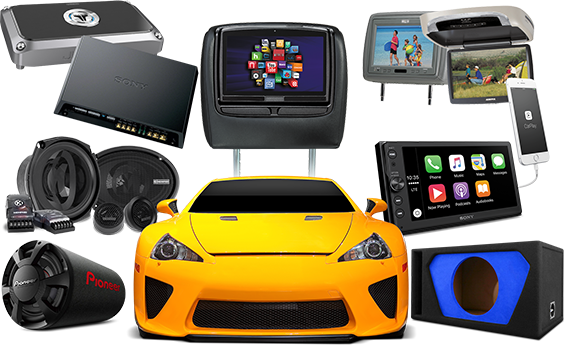When it comes to upgrading your car audio system, choosing the right speakers is one of the most important decisions you’ll make. The right set of speakers doesn’t just make your music louder—it makes it come alive. Crisp highs, smooth mids, and powerful lows create a balanced listening experience that turns every drive into a pleasure. However, with so many options on the market, many car owners struggle to pick the right fit for their setup.
In this guide, we’ll walk through how to choose the right speakers for crisp, clear sound on the road, and highlight key factors you should consider before making your investment.
Understand Your Listening Goals
The first step in choosing the right speakers is to identify what kind of sound experience you want. Do you prefer deep bass that shakes the car, or are you more interested in crystal-clear vocals and instrumentals? For example, while subwoofers handle low frequencies, your speakers should be chosen based on how well they handle mids and highs. If your system includes a powerhouse sub like the Pride Solo 300 Competition, your main speakers should balance that bass with clean, accurate upper ranges.
Consider Speaker Types
Car speakers come in two main types:
-
Coaxial Speakers (Full-Range): These combine multiple drivers—typically a woofer and a tweeter—into one unit. They’re budget-friendly, easy to install, and provide good all-around performance.
-
Component Speakers: These separate the woofer, tweeter, and crossover into different units for optimal sound quality. They’re ideal for audiophiles who want maximum clarity and control over their setup.
For crisp, clear sound, component speakers usually offer better performance, as you can position tweeters for optimal imaging and sound staging.
Match Power and Sensitivity
One of the biggest mistakes people make is mismatching their speakers with their amplifier. Always check RMS power ratings, not just peak power. Your amplifier should deliver clean power within the speaker’s handling capacity.
-
High Sensitivity Speakers: Great for low-power systems since they produce more volume with less power.
-
Lower Sensitivity Speakers: Better suited for high-powered amplifiers, as they can handle more input without distortion.
If you’re running a competition-grade subwoofer like the Pride Solo 300 Competition, you’ll likely need speakers with the durability and power handling to match the intensity of your system.
Pay Attention to Speaker Materials
Speaker construction plays a huge role in sound quality and durability:
-
Tweeters: Look for silk or textile blends for smooth highs, or metal and ceramic materials for brighter tones.
-
Woofers: Polypropylene cones are lightweight and provide solid performance. For higher-end builds, woven fabrics or Kevlar cones offer excellent response.
-
Surrounds: Rubber surrounds last longer and perform better under stress compared to foam or cloth.
Choosing the right materials ensures your speakers deliver consistent, accurate sound for years.
Size and Fit Matter
Not all speakers fit every vehicle. Factory speaker locations may limit the size you can install without modifications. Before purchasing, measure your existing speaker mounts or consult your vehicle’s manual. Many cars accommodate 6.5-inch speakers, but upgrading may require custom brackets or slight modifications for a better fit.
If you’re building a high-performance system, it’s worth investing in proper installation to ensure your speakers are secure and positioned correctly for optimal sound staging.
Don’t Forget Crossovers
Crossovers are essential for directing frequencies to the correct driver (lows to woofers, highs to tweeters). Many component speaker systems include high-quality external crossovers, which improve clarity by preventing overlap and distortion. Without them, your system may sound muddy or unbalanced.
When matched properly, a crossover ensures your system produces crisp highs and rich mids without interfering with the subwoofer’s low frequencies.
Soundproofing for Better Performance
Even the best speakers won’t sound their best in a noisy car. Adding sound-deadening materials to your doors and panels helps eliminate vibrations and road noise, allowing your new speakers to perform at their peak. This step is often overlooked but is one of the easiest ways to get crisp, clear sound.
Balance with the Rest of Your System
Speakers don’t work in isolation—they’re part of a larger system. If your subwoofer is extremely powerful, like the Pride Solo 300 Competition, you’ll need speakers and amplifiers that can keep up. Otherwise, the bass will overpower everything else, leaving vocals and instruments drowned out. Always balance your system so every frequency range shines through.
Test Before You Buy
Whenever possible, test speakers before purchasing. Bring your favorite music tracks and listen for clarity, balance, and detail. Notice whether vocals sound natural, highs are crisp without being harsh, and mids blend smoothly. Every listener has unique preferences, and hearing the speakers in action is the best way to make the right decision.
Final Thoughts
Choosing the right speakers for crisp, clear sound on the road requires more than just picking the biggest or most expensive option. It’s about finding the perfect balance between your goals, your subwoofer setup, and your vehicle’s acoustics. Pay attention to power handling, materials, and placement, and don’t forget about tuning and soundproofing.
If you’re pairing your speakers with a high-powered sub like the Pride Solo 300 Competition, make sure your system is balanced for both clarity and power. With the right choices, you’ll enjoy a rich, detailed audio experience every time you hit the road.






